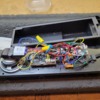Well, this has graced the shelves long enough, it's time to allow it on the layout. Since I'm strictly command, first step is a command upgrade. For this one, I decided on a Legacy upgrade.
I popped it open and right away a small problem arose, no flywheel! That precludes the RCMC upgrade, no room for a flywheel! So, to my secondary plan, use the Legacy BEMC back-EMF board instead.
This is the complete chassis, the two plugs go to the shell.
Another problem with no flywheel, the BEMC uses a hall effect sensor on an axle to generate the chuffs. I have a custom coded Chuff-Generator I use for BEMC, but it also needs a flywheel. But wait!!! There's a 2-lobe cam on the axle in the big hole over the first drivers. I fabricated an aluminum bracket for a chuff switch and mounted it. In a wonderful twist of fate, the BEMC has an odd behavior of it's hall effect sensor. It toggles from positive to negative for a chuff, then for the next chuff from negative for positive. By using all the contacts of the chuff switch, I had that exact behavior and generated 4-chuffs/rev in the process, perfect!
I mounted the BEMC on an aluminum base with a tab folded up for a heatsink, and covered the base with Styrene to insulate the bottom of the PCB.
The board assembly slips inside the boiler tube and screws to the convenient screws that were holding the CV power supply for lighting and the Seuthe smoke unit. Naturally, I also included a fan driven smoke unit and LED headlight.
Here's the shell complete with all the wiring done, the two connectors join to the chassis and the wires get tucked into the boiler tube. I used a pair of LED's for the flickering firebox and another for the cab light. Not shown is the aluminum duct tape covering the flickering firebox, I found that the LED's were leaking light down on the track.
In an odd layout, I put the TMCC RCDR in the tender and not with the BEMC board where it normally goes. That was due to the fact that there is no easy way to do an antenna on the locomotive. Nothing detaches so I could insulate it for an antenna, many times you can use the pilot, not today.
Here's the tender with all the parts mounted. In another odd twist, I didn't have to do anything special to create a TMCC antenna for the tender. Apparently, the SGL locomotives are "TMCC Ready", because the tender shell was already insulated with a wire soldered to it for an antenna. It was obviously a factory job because it was way too need even for a craftsman to have done. The insulating gasket was obviously punched out to shape, and the screws were all insulated from the chassis with special washers..
An oddity of having the RCDR in the tender is I had to send the serial data two ways! I had to send it up to the BEMC in the locomotive, but since the chuff switch is in the locomotive and inputs directly into the BEMC, I had to send the composite serial data back to the tender, with out that link, I was missing the chuff!
Wiring finished, just have to dress it up a little and pop the shell on and it'll be ready.
And here's a drive-by with the completed upgrade! The only thing left to do is to put a better sound board in it, I have one for the Pacific coming, but it's not here yet.
















